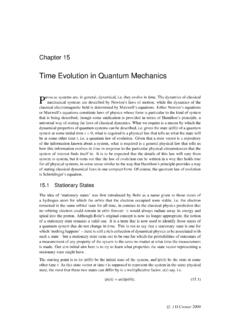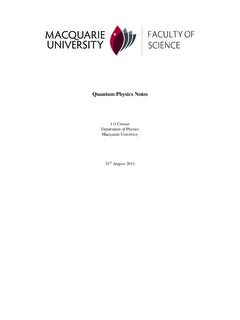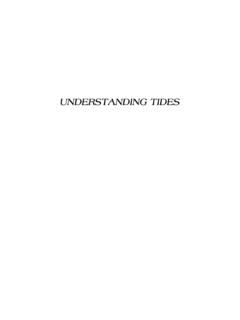Transcription of Particle Spin and the Stern-Gerlach Experiment
1 Chapter 6 Particle Spin and the Stern-Gerlach ExperimentThespin of an elementary Particle would appear, on the surface, to be little different from thespin of a macroscopic object the image of a microscopic sphere spinning around some axiscomes to mind. However, there is far more going on here than what this simple picture mightsuggest. But first, a brief look at what the classical properties are of angular momentum is Spin Angular MomentumA Particle moving through space possesses angular momentum, a vector, defined byL=r p( )whererandpare the position vector and momentum respectively of the Particle . This is some-times referred to asorbitalangular momentum since, in particular, it is an important considerationin describing the properties of a Particle orbiting around some centre of attraction such as, in theclassical picture of an atom, electrons orbiting around an atomic nucleus.
2 Classically there is norestriction on the magnitude or direction of orbital angular a classical perspective, as an electron carries a charge, its orbital motion will result in atiny current loop which will produce a dipolar magnetic field. The strength of this dipole field ismeasured by the magnetic moment which is related to the orbital angular momentum by L L L=q2mL.( )Thus, the expectation on the basis of this classical picture is that atoms can behave as tiny classical idea of spin follows directly from the above considerations. Spin is the angularmomentum we associate with a rotating object such as a spinning golf ball, or the spinning angular momentum of such a body can be calculated by integrating over the contributions tothe angular momentum due to the motion of each of the infinitesimal masses making up the well known result is that the total angular momentum or spinSis given byS=I ( )whereIis the moment of inertia of the body, and is its angular velocity.
3 Spin is a vector whichpoints along the axis of rotation in a direction determined by the right hand rule: curl the fingers ofthe right hand in the direction of rotation and the thumb points in the direction ofS. The momentof inertia is determined by the distribution of mass in the rotating body relative to the axis ofrotation. If the object were a solid uniform sphere of massmand radiusa, and rotation were abouta diameter of the sphere, then the moment of inertia can be shown to beI=25Ma2.( )c J D Cresser 2009 Chapter 6 Particle Spin and the Stern-Gerlach Experiment55 Smagneticfieldspinangularmomentum Northpole Figure :Magnetic field produced by aspinning charged the sphere possesses an electric charge, then the cir-culation of the charge around the axis of rotation willconstitute a current and hence will give rise to a mag-netic field.
4 This field is a dipole field whose strength ismeasured by the dipole moment which can be shown,for a uniformly charged sphere of total chargeq, to begiven by S S S=q2mS,( )exactly the same as in the orbital point to be made here is that the spinning object isextended in space, the spinning sphere example has a non-zero radius. If we try to extendthe idea to apointparticle by taking the limit ofa 0 we immediately see that the spin angularmomentum must vanish unless is allowed to be infinitely large. If we exclude this last possibility,then classically a point Particle can only have a spin angular momentum of zero and so it cannothave a magnetic moment. Thus, from the point-of-view of classical physics, elementary particlessuch as an electron, which are known to possess spin angular momentum, cannot be viewed aspoint objects they must be considered as tiny spinning spheres.
5 But as far as it has been possibleto determine by high energy scattering experiments, elementary particles such as the electronbehave very much as point particles. Whatever radius they might have, it is certainly very tiny: Experiment suggests it is<10 17m. Yet they are found to possess spin angular momentumof a magnitude equal (for the electron) to 3/!/2 which requires the surface of the Particle tobe moving at a speed greater than that of light. This conflict with special relativity makes thisclassical picture of an elementary Particle as a tiny, rapidly rotating sphere obviously resolution of this problem can be found within quantum mechanics, though this requiresconsidering the relativistic version of quantum mechanics: the spin of a point Particle is identifiedas a relativistic effect.
6 We shall be making use of what quantum mechanics tells us about particlespin, though we will not be looking at its relativistic underpinnings. On thing we do learn, however,is that spin is not describable in terms of the wave function idea that we have been working withup till Spin Angular MomentumWave mechanics and the wave function describe the properties of a Particle moving through space,giving, as we have seen, information on its position, momentum, energy. In addition it also pro-vides, via the quantum mechanical version ofL=r pa quantum description of theorbitalan-gular momentum of a Particle , such as that associated with an electron moving in an orbit aroundan atomic nucleus.
7 The general results found are that the magnitude of the angular momentum islimited to the valuesL= l(l+1)!,l=0,1,2,3,..,( )which can be looked on as an improved version of the result used by Bohr, the one subsequently justified by the de Broglie hypothesis, that isL=n!, Eq. ( ). The quantum theory of orbitalangular momentum also tells us that any one vector component ofL,Lzsay, is restricted to thevaluesLz=ml!,ml= l, l+1, l+2,..l 2,l 1,l.( )This restriction on the possible values ofLzmean that the angular momentum vector can have onlycertain orientations in space a result known as space quantization .All this is built around the quantum mechanical version ofL=r p, and so implicitly is concernedwith the angular momentum of a Particle moving through space.
8 But a more general perspectiveyields some surprises. If special relativity and quantum mechanics are combined, it is found thatc J D Cresser 2009 Chapter 6 Particle Spin and the Stern-Gerlach Experiment56even if a Particle , a point object, has zero momentum, so that the orbital angular momentum iszero, its total angular momentum is, in general,not zero. The only interpretation that can beoffered is that this angular momentum is due to the intrinsic spin of the Particle . The possiblevalues for the magnitudeSof the spin angular momentum turn out to beS= s(s+1)!,s=0,12,1,32, ,( )and any one vector component ofS,Szsay, is restricted to the valuesSz=ml!,ms= s, s+1, s+2,..s 2,s 1,s( ) similar to orbital angular momentum, but with the significant difference of the appearance ofhalf integer values for the spin quantum numbersin addition to the integer values.
9 This the-oretical result is confirmed by Experiment . In nature there exist elementary particles for whichs=12,32, as the electron, proton, neutron, quark (all of which have spins=12), andmore exotic particles of higher half-integer spin, while there exist many particles with integer spin,the photon, for whichs=1, being the most well-known example, though because it is a zero restmass Particle , it turns out thatSzcan only have the values 1. Of particular interest here is thecase ofs=12for which there are two possible values forSz, that isSz= 12!. Particle spin is what is left after the contribution to the angular momentum due to motion throughspace has been removed. It is angular momentum associated with the internal degrees of freedomof a point Particle , whatever they may be, and cannot be described mathematically in terms of awave function.
10 It also has no classical analogue: we have already seen that a point Particle cannothave spin angular momentum. Thus, Particle spin is a truly quantum property that cannot bedescribed in the language of wave functions a more general mathematical language is was in fact the discovery of Particle spin, in particular the spin of the electron, that lead tothe development of a more general version of quantum mechanics than that implied by is one classical property of angular momentum that does carry over to quantum the Particle is charged, and if it possesses either orbital or spin angular momentum, then therearises a dipole magnetic field. In the case of the electron, the dipole moment is found to be givenby S S S= e2megS( )wheremeand eare the mass and charge of the electron,Sis the spin angular momentum ofthe electron, andgis the so-called gyromagnetic ratio, which classically is exactly equal to one,but is known (both from measurement and as derived from relativistic quantum mechanics) to beapproximately equal to two for an electron.















